Answers to Quiz Questions and Other Comments, part 2
Answers to Quiz Questions and Other Comments, part 2
by Marc B. Shapiro
1. In my previous post, in discussing the words in Ecclesiastes 2:8 עשיתי לי שרים ושרות, I referred to the interpretation in Kohelet Rabbati. This very section of Kohelet Rabbati has an amazing comment, which as far as I know was never referred to in the dispute over Sara Hurwitz’ rabbinical ordination. Commenting on the words שדה ושדות, which appear in the same sentence as שרים ושרות, the Midrash states:
שדה ושדות: דיינים זכרים ודיינות נקבות
In other words, Solomon is portrayed as appointing female dayanim! (See also Ruth Rabbah 1:1 where Deborah and Yael are described as judges.[1]) The standard commentaries find this passage very difficult and offer alternative explanations, sometimes in opposition to the plain sense of the words. Etz Yosef suggests that the job of the women was to judge other women. R. David Luria adopts the lav davka approach, and assumes that דיינות must mean policewomen of sorts.
ודיינות נקבות: לאו דווקא דיינות דאשה פסולה לדון. אלא שופטת להשגיח שלא ישלטו [ישלחו?] הנשים בעולתה איש לרעותה את ידה
His position is rejected by R. Abraham Horowitz, Kinyan Torah ba-Halakhah, vol 1, no. 8:3. Rabbi Horowitz, who was a member of the Edah Haredit beit din, assumed that when the Midrash referred to female dayanim, it didn’t mean that they actually took part in beit din proceedings, but it did mean that they decided halakhic matters, and in that sense they are דיינות. Here are his words, which everyone should examine closely.
ובאמת ל”י [לא ידעתי] מה החרדה הזאת דהא הפת”ש בחו”מ סי’ ז’ סק”ה הביא מספר החינוך מצוה קנ”ח דאשה חכמה ראוי’ להורות . . . אפש”ל דיינות שנתמנו [ע”י שלמה] רק לפסוק הוראה ולא לדון. ועימנ”ח סו”מ ע”ח דפשיטא לי’ דנשים מצטרפות לרוב חכמי הדור אם חולקין באיזו דין . . . מכ”ז נראה דאין לזלזל בסמכות אשה כשירה
I requested that readers examine his words, because in the backlash over Hurwitz’ ordination a number of statements were made the upshot of which was that halakhic decision-making is reserved for men. Ironically, this position is given support by at least some of the women serving as yoatzot, for they are careful to stress that while they provide guidance, they don’t, Heaven forbid, actually decide halakhah. When there is a real halakhic question they turn to the experts, that is, the male rabbis. The message of this is, of course, that women, no matter how learned, are disqualified from deciding halakhah.[2]
Returning to Kohelet Rabbati, R. Yisrael Be’eri accepts that the Midrash means what it says when it refers to dayanim, but suggests that Solomon not only had female courts, but also “co-ed” batei din. See Ha-Midrash ka-Halakhah (Nes Tziyonah, 1960), p. 317:
ולולי מסתפינא אמינא שזה היה הרכב זוגי ז”א אותו דין היה מתברר בפני בי”ד רגיל וכן הוסיף שיתברר בפני דיינות נקבות שאולי יש בהן בינה יתירה וגישה מיוחדת ואחר כך שוקלין זה מול זה ואז היה מתברר הדין בדקדוק ושיקול מיוחד וצ”ע.
It is noteworthy that he sees value in having the female dayanim examine the matter, since they can bring a feminine perspective to bear. If I just presented the text without telling you who the author was and when it was written, I am sure people would assume that only a modern feminist type could have penned these words. Yet we see that this is not the case.
R. Hayyim David Halevi also deals with this Midrash (Aseh Lekha Rav, vol. 8, pp. 247-248). He suggests that the Midrash is indeed operating under the assumption that there is no problem with women dayanim. Alternatively, he suggests that Solomon and his council accepted the authority of the women, and therefore this was permissible. In other words, there is only a halakhic problem when a woman is made a dayan against the will of the community, but if she is accepted by them, then she can serve. And how do we determine if the community accepts her as a dayan? Halevi explains:
וקבלה ודאי שמועילה, והכל כשרים לדון בקבלה, וקבלת גדולי הקהל מספיקה ואין צורך שכל העומדים לדין יקבלו עליהם. וכן מצאנו “דיינות נקבות” כלשון המדרש, ואין סתירה להלכה
What this means is that if the leaders of the community accept women dayanim, then this is sufficient. (I am speaking about in matters of Hoshen Mishpat, not dayanim for Even ha-Ezer.) Therefore, if leaders of the OU or the RCA declare that they accept women, that would open the door to appointing a woman as a dayan on the RCA beit din. Halevi refers to acceptance by גדולי הקהל. In the context of the United States, where there are lots of different kehilot, I would assume that this means that if the leaders of any one community, or even of one synagogue, agree to accept a woman as dayan, then this is sufficient.
R. Ben Zion Uziel also claimed that women can serve as dayanim, and the means of achieving this would be through a takanah. He cites meta-halakhic reasons to explain why this is not a good idea, but from a pure halakhic standpoint, he sees it as entirely acceptable.[3]
Leaving aside the issue of serving as a dayan, it is obvious to me that women rabbis are coming to Modern Orthodoxy, even if the powers that be are standing firmly against it. Yet they have already let the genie out of the bottle. By sanctioning advanced Torah study for women, there is no question that the time will come when there will be women scholars of halakhah who are able to decide issues of Jewish law. The notion that a woman who has the knowledge can “poskin” is not really controversial, and has been acknowledged by many haredi writers as well.[4] Very few rabbis are poskim, but every posek is by definition a “rabbi”, whether he, or she, has received ordination or not.[5] So when we have women who are answering difficult questions of Jewish law, they will be “rabbis”,[6] and no declarations by the RCA or the Agudah will be able to change matters. I am not talking about pulpit rabbis, as this position has its own dynamic and for practical reasons may indeed not be suitable for a woman. Yet as we all know, very few rabbis function in a pulpit setting, and much fewer will ever serve as a dayan on a beit din.
The reason why the issue of ordaining women has been so problematic is because the Orthodox community is simply not ready for it. Yet when women will achieve the level of scholarship that I refer to, and are already deciding matters of halakhah, then their “ordination” will not be regarded as at all controversial in the Modern Orthodox world, and will be seen as a natural progression. People will respond to this no differently than how they responded to the creation of advanced Torah institutes for women. [7] Since women were already being taught Talmud, the creation of these institutes was a natural step.
There is one more thing that needs to be added, and that is that we have not reached the point where there are women halakhic authorities.[8] I hope I won’t be accused of bashing women by pointing out the following fact, that as of 2012 not one traditional sefer, in Hebrew, written by a woman has been published. By traditional sefer I mean a halakhic work or a commentary on a talmudic tractate. I am waiting for this day, which I hope won’t be too long in the future. I also hope that a learned woman is currently working on a commentary to a tractate, even if it is one of the easier tractates such as Megillah. The point is that for women to be recognized as talmudic and halakhic authorities they will have to do exactly what the men do, and that is show the world that they are serious talmidot hakhamim. The major way to do this is through publishing. (Publishing has its own significance, even if no one actually reads the book. Let’s be honest, of the many volumes of commentary on talmudic tractates that are published by people in yeshiva and kollel every year, does anyone read them? With so many great works of rishonim and aharonim on the tractates, as well as the writings of contemporary gedolim, the modern commentaries by unknown talmidei hakhamim are understandably not anyone’s focus. Yet they are of great benefit to the author, in developing his ideas and advancing his learning, and that is reason enough for the works to appear.)
I agree that it isn’t “fair” that while men can be given the title “rabbi” simply by learning sections of Yoreh Deah, the women must do a lot more to be accepted. But that is required any time new developments come into place. I have been assured by people in the know that the day is coming when we will have first-rate women halakhists and talmudists. It will be fascinating to see what insights they bring to matters, and if a woman’s perspective affects how halakhah is decided. But we haven’t reached that day yet, and just as importantly, the Orthodox world as a whole is not yet ready for that day, as they have not yet become comfortable with the idea of a woman poseket.
In note 7 I refer to the recent article by Broyde and Brody in Hakirah 11. While they leave open the possibility of a future with women rabbis, R. Hershel Schachter also has a very short article in that issue, and he is completely opposed. What I think is interesting is that the only recent authority he cites in support of his rejection of women rabbis is “Rabbi Shaul Lieberman.” I guess R. Schachter regards Lieberman as one of the gedolei Yisrael.[9]
Regarding R. Schachter’s opposition to women rabbis, there is one other point worth noting. In an earlier post, available here, I wrote as follows:
R. Hayyim Joseph David Azulai has an entry for “rabbanit” in his Shem ha-Gedolim. He lists there a few learned women. When Azulai uses the term rabbanit, it does not mean “rebbetzin” but “female rabbi”. I am sure that there are those who would object to the Hida that these women were never “ordained”. Yet the Hida also includes many others who were not ordained, but I don’t think anyone would take the title of “rabbi” away from them. One such figure is Moses ben Maimon.
My point in this was to show that women have already been given the title approximating that of rabbi by no less than the Hida (obviously in a pre-feminist context).[10] As far as I know, I was the only one to make this point during the hullabaloo a couple of years ago about the ordination of Sara Hurwitz. I was surprised that no one else picked up on this as I happen to think it would give the pro-ordination side a strong piece of ammunition.
My post went up on June 25, 2010, and someone must have mentioned this to R. Schachter because on July 7, 2010 he responded. You can listen to what he says here (beginning at minute 6). He mentions that the Hida’s use of rabbanit was cited in support of women’s ordination, and concludes that nevertheless this proof is “not so conclusive.” [11]
Flora Sassoon (1859-1936) was an extremely learned woman who lived too late to be included by the Hida.[12] In 2007 the Sassoon family published Nahalat Avot, which is a large collection of letters sent to the Sassoons by great Torah figures. Many of the Torah letters in this book were sent to Flora, and she is addressed in a number of them as “rabbanit”. Her husband held no rabbinic office and I think we can therefore conclude that the term “rabbanit” is being used as a title of respect for her knowledge.[13] Another example of this is seen in how she is introduced by R. Joel Herzog, who published a derashah she delivered in his Imrei Yoel, vol. 3, pp. 204-206. (Are there any other examples of a traditional sefer including something written by a woman?) Herzog too uses the term rabbanit as a title of respect.
Finally, with regard to women’s roles, let me call attention to what I think is a little known fact. Liberal Orthodoxy is very interested in finding ways to expand the opportunities for women to be involved in Jewish rituals. This encompasses everything from reading the Torah and leading Kabbalat Shabbat, to reciting sheva berakhot and reading the ketubah at a wedding. I haven’t yet seen any proposals to have a woman serve as a sandak. This would not be a new practice. R. Meir of Rothenburg writes that in his day in “most places” a woman sat in the synagogue and held the baby during circumcision.[14] In other words, this was the mainstream Ashkenazic minhag. R. Meir opposed this practice and made efforts to uproot it. This opposition was successful and is the background of R. Moses Isserles, Shulhan Arukh, Yoreh Deah 265:11, declaring that a woman cannot be a sandak, because it is peritzut.[15] Yet despite Rama’s comment, my experience is that this is the sort of judgment that the liberal Orthodox are quick to revise. Certainly, the Rama would assume that there is more peritzut in having a woman serve as a hazzan than in holding the baby during a circumcision. Yet for some reason, while the latter has become accepted on the left of Orthodoxy, I haven’t heard anyone speak about instituting female sandakot. (If there are places where women are indeed serving as sandakot, please leave a comment.)
2. In an earlier post I discussed how R. Moses Kunitz’s biography of R. Judah the Prince was censored from a recent printing of the classic Vilna Mishnah. I also included a picture of Kunitz. Here is another, completely unknown, picture of Kunitz.
I found it in the Yeshiva University Archives, call no. 1992.008, and I thank the Archives for permission to publish it here.

In the earlier post dealing with Kunitz, I wrote:
Immediately following Kunitz’ essay, there is another article on the grammar of Mishnaic Hebrew by Solomon Loewisohn.[16] In the very first note he refers to the book of Ecclesiastes, and concludes his comment with והטעם ידוע למשכילי עם. What he is alluding to in this note is that Ecclesiastes is a late biblical book, and thus could not have been written by Solomon. To show this he points to the word חוץ, which in its usage in Ecclesiastes 2:25 is an Aramaism, and thus post-dates the biblical Hebrew of Solomon’s day. To use an expression of the Sages, we live in an olam hafukh. Kunitz’ essay was thought worthy of censorship, and at the same time this note remains in every printing of the Vilna edition of the Mishnah. Yet as I mentioned above, let’s see how long it is before this note, or even the complete essay, is also removed.
What I didn’t realize, and I thank an anonymous commenter for pointing out, is that this note has already been tampered with, and in such an ingenious fashion that there is now no need for it to be deleted. Here is how it appears in the Vilna Mishnah.[17]
And here is the page in the 1999 Zekher Hanokh edition of the Mishnah, published by Wagshal (an edition which also deletes Kunitz’ introduction).
Now, instead of והטעם ידוע למשכילי עם, we have והדבר ידוע למשכילי עם. In the original, Loewisohn is telling the reader that the reason why there is an Aramaism in Ecclesiastes is known to the wise (i.e., the book is post-Solomonic), In the Zekher Hanokh edition all he is saying is that the existence of Aramaisms in Ecclesiastes is known to the wise, with no daring implication as to dating.
I also found something else of interest. Here is the last page of Kunitz’ essay on R. Judah the Prince.
Notice how he mentions Mendelssohn, Rabe’s German translation of the Mishnah, and how in his opinion R. Judah would be happy with such a translation.
This all sounds a little too “maskilish,” and here is what same page looks like as it appears on Otzar ha-Hokhmah.
Look at what has been removed. Is there really such an edition with the removed lines, or did Otzar ha-Hokhmah censor the material itself? (I will return to the censorship of Kunitz in the next post, as new information regarding this has recently come to light.)
There are other examples where I think it is Otzar ha-Hokhmah that is responsible for the censorship. Here is the title page of the book Va-Yakem Edut be-Yaakov (Prague, 1594) as it appears on Otzar ha-Hokhmah
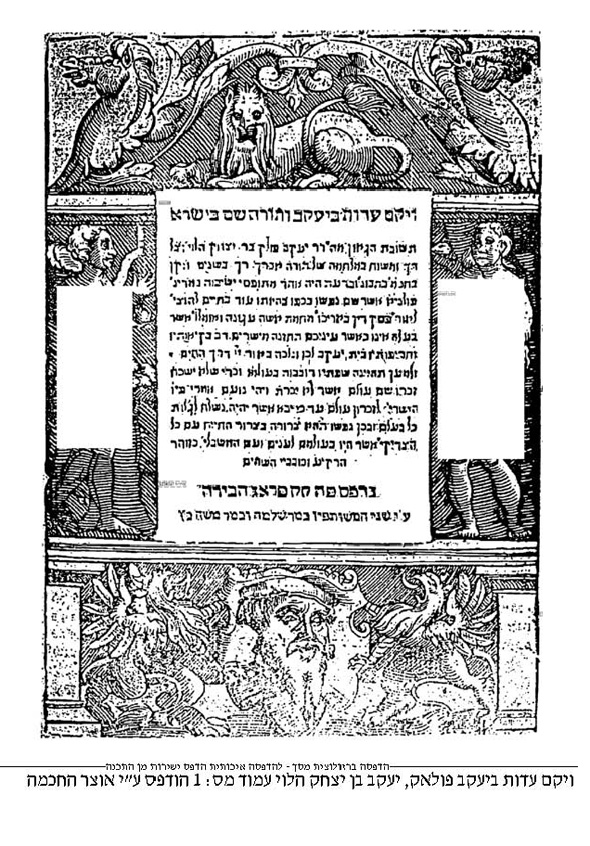
Here is the uncensored page, as is found on hebrewbooks.org

Incidentally, the title page of R. Yitzhak Chajes’ Derashah (Prague, 1589) used the exact same model.

Dan already discussed the Chajes title page here and called attention to how an auction catalog ridiculously suggested, without any evidence whatsoever, that the non-Jewish workers of the Jewish publisher put this immodest picture in.
How were the workers able to get away with this? The catalog has the “religiously correct” answer: it was hol ha-moed and the owner was not around! Since a pious Jew would never have anything to do with such a picture, the non-Jewish workers must have used their own money to buy the plates for this engraving. And why would the non-Jewish workers have spent their own money doing something that would anger the owner and get them fired? It must be that they wanted to cause Jews trouble, which is what non-Jews are always interested in. Knowing that when the owner saw what they did he would never agree to sell a book with such a title page, the non-Jewish workers must have taken all the books from the printing press and, at their own expense, sent them out to all the book sellers. All this could happen without the owner being aware because it was hol ha-moed and during this time the owner of the press wouldn’t dream of dropping by his shop (so much did he trust his workers), just like today none of us know any religious Jews who would ever consider going to work on hol ha-moed.
The title page of Va-Yakem Edut be-Yaakov, published in Prague five years after Chajes’ Derashah appeared, shows us that the non-Jewish workers must have once more, on hol ha-moed of course, surreptitiously inserted the same picture as a title page for a different book. I think everyone has to wonder, why didn’t the publisher learn anything from the first time these non-Jewish trouble makers played around with a Jewish printing press?
Another example of censorship on Otzar ha-Hokhmah is seen with the Venice 1574 edition of the Mishneh Torah. Here is the title page.
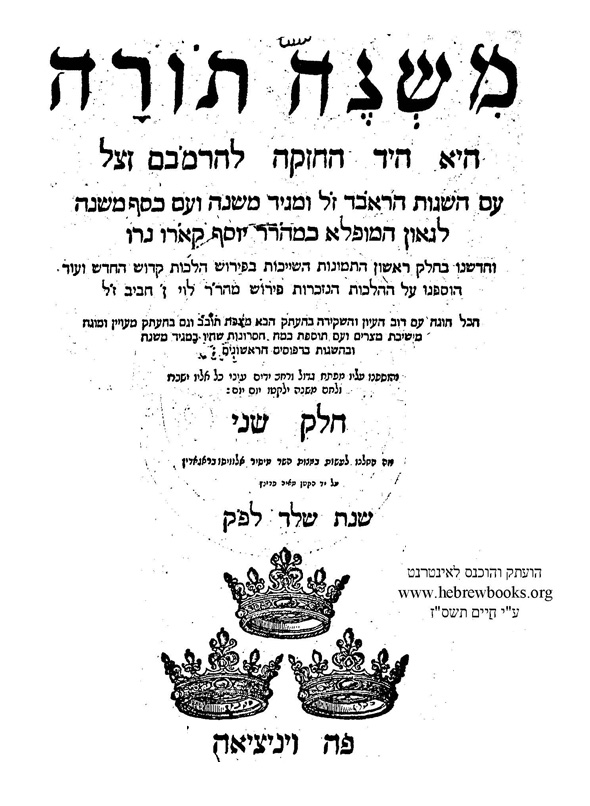
Here is how the second page looks, from volume 2 (as seen on hebrewbooks.org). The verse along the edges is from Psalm 45:12: “The king shall desire your beauty.”.

This edition was published in four volumes. In the copy on Otzar ha-Hokhmah, three of the four volumes contain the second page. Two of the pictures are significantly whited out, and in the second picture below you can see that they have whited out enough so that the reader will think he is looking at a man.
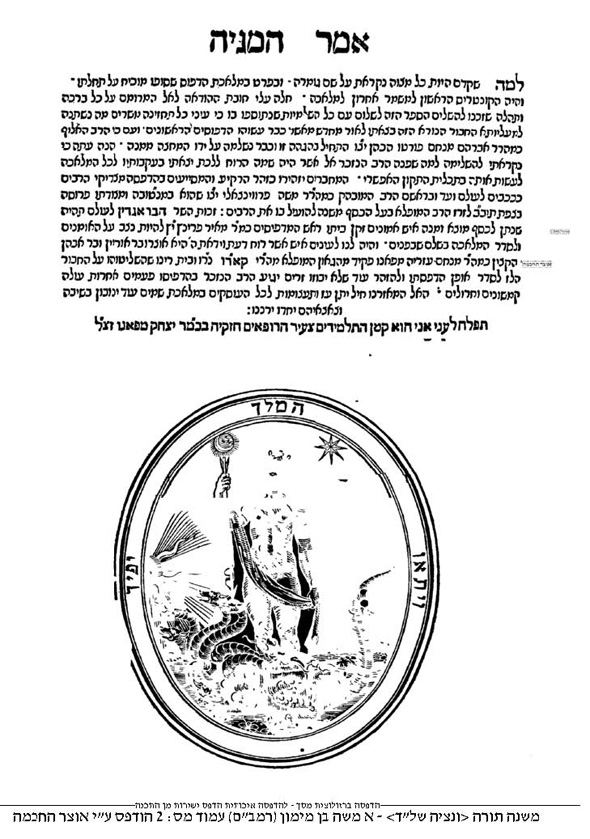
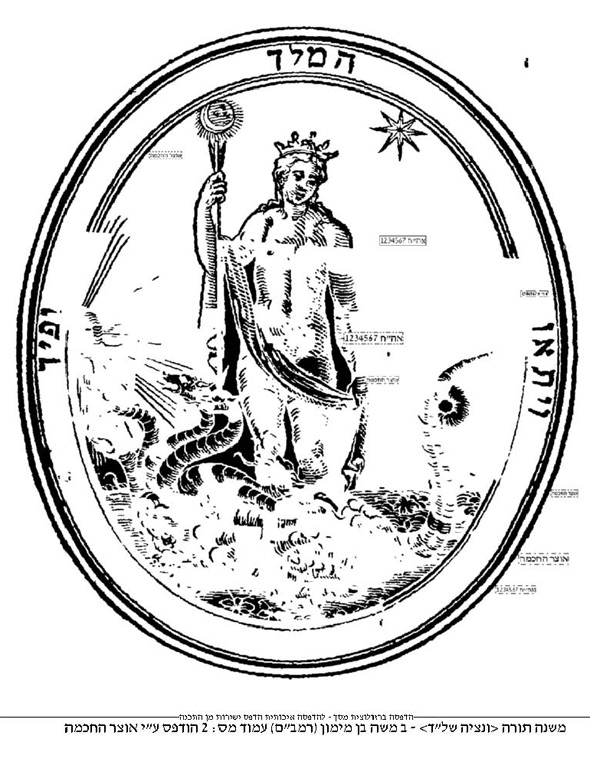

There are, to be sure, plenty of examples where the pictures appear without any censorship on Otzar ha-Hokhmah (and even with the examples I have given, it is not clear if Otzar ha-Hokhmah is responsible for the censorship or the book came to them this way). Here, for example, is the famous family crest of R. Abraham Menahem Rapa of Porto, which appears at the end of his Minhah Belulah.

S. has already pointed out that this picture was altered in a recent printing of the sefer.[18] Here is what the altered version looks like.
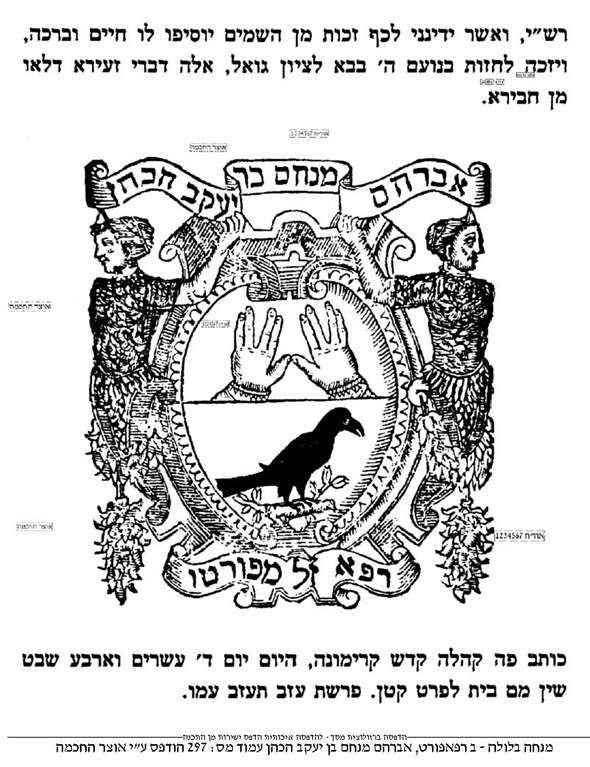
Michael Silber has noted that in Binyamin Shlomo Hamburger’s recent book Ha-Yeshiva be-Fiorda, the women have been turned into men, complete with beards![19]
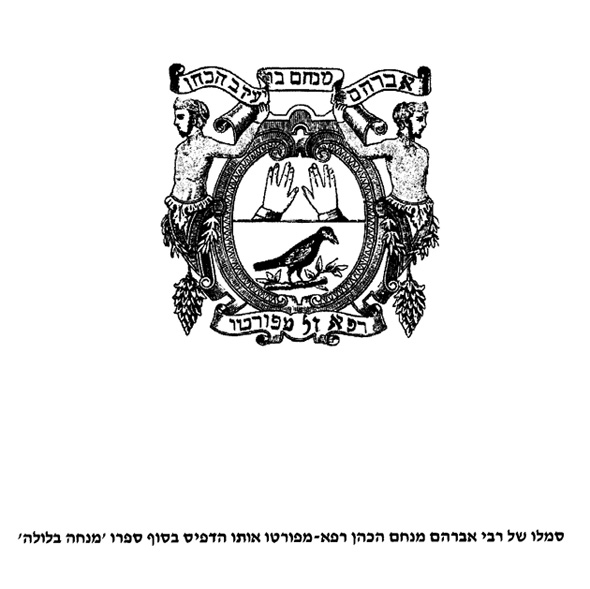
Here is what the Encyclopaedia Judaica, s.v. Rapoport, writes:
The name Rapa originated in the German Rabe (Rappe in Middle High German), i.e., a raven. In order to distinguish themselves from other members of the Rapa family, the members of this family added the name of the town of Porto, and thus the name Rapoport was formed . . . The family escutcheon of Abraham Rapa of Porto shows a raven surmounted by two hands raised in blessing (indicating the family’s priestly descent).
Regarding the sefer Minhah Belulah, at the beginning of each book of the Pentateuch the following “immodest” picture also appears.
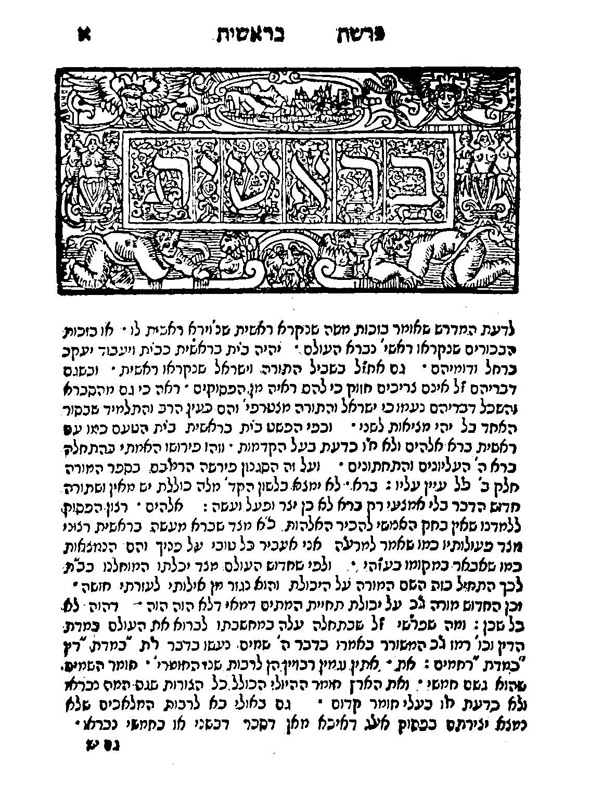
As far as I know, hebrewbooks.org has not censored any of the books that appear on the site. (We have previously discussed books that it refuses to put up.) A few years ago the Reich collection of reprints was added to hebrewbooks.org and these have all sorts of interesting title pages. Here is the title page of R. Samuel ben David Ha-Levi’s Nahalat Shivah.
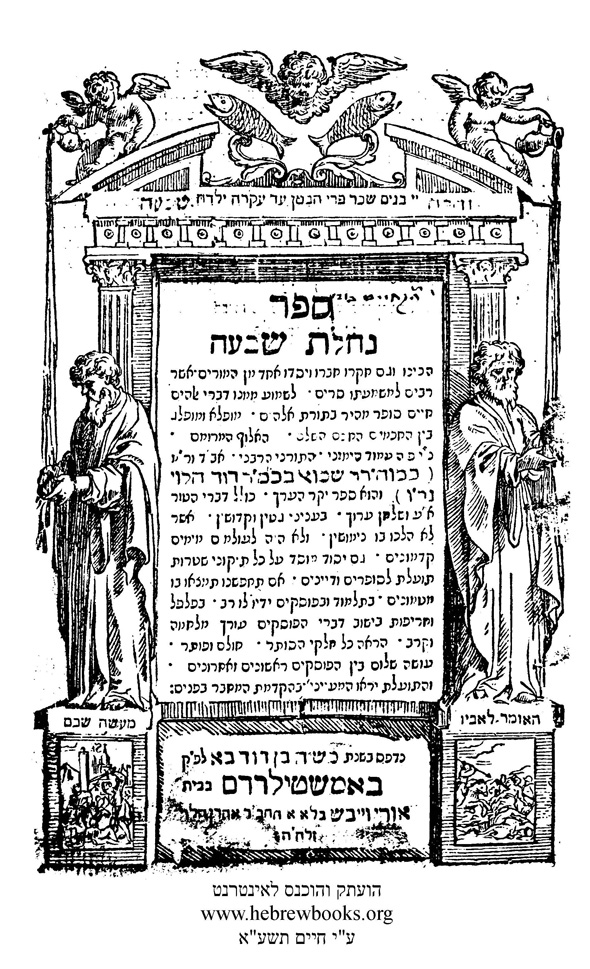
The year is expressed as משיח בן דוד בא. This adds up to 427 (i.e., 5427), and is an allusion towards Shabbetai Zvi. The year 5427 corresponded to 1666-1667, and the convention normally would be to write 1667 (and this is the date given in the Harvard catalog). However, in this case I assume it is more accurate to give the date as 1666. We know that Shabbetai Zvi converted on September 15, 1666. By 1667 this information would have reached Amsterdam and the title page would no longer refer to him as the Messiah. Therefore, I think we can conclude that the book appeared after Rosh ha-Shanah of 1666, but before January 1, 1667. Nevertheless, it is noteworthy that if you look at the end of the book there is a comment by the typesetter from which we see that, despite the date on the title page, the book was not actually ready for publication until the beginning of 1668. In other words, the title page was not changed in the interim, despite Shabbetai Zvi’s apostasy.
Among the Reich reprints, here is another fascinating title page (actually the first of two title pages in this book). It is from R. Abraham ben Shabbetai’s Kehunat Avraham (Venice 1719).
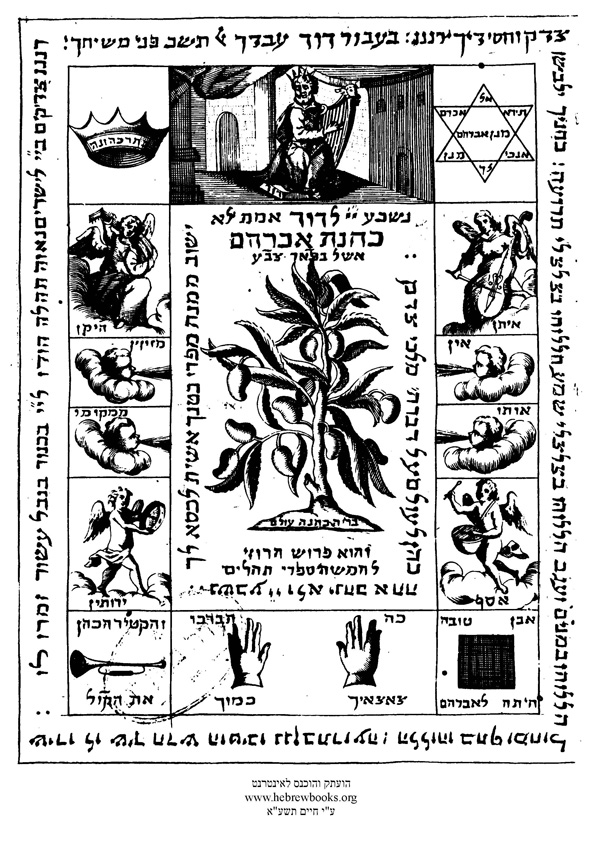
Here is the author’s picture, that appears on the second page. He clearly is wearing a wig.
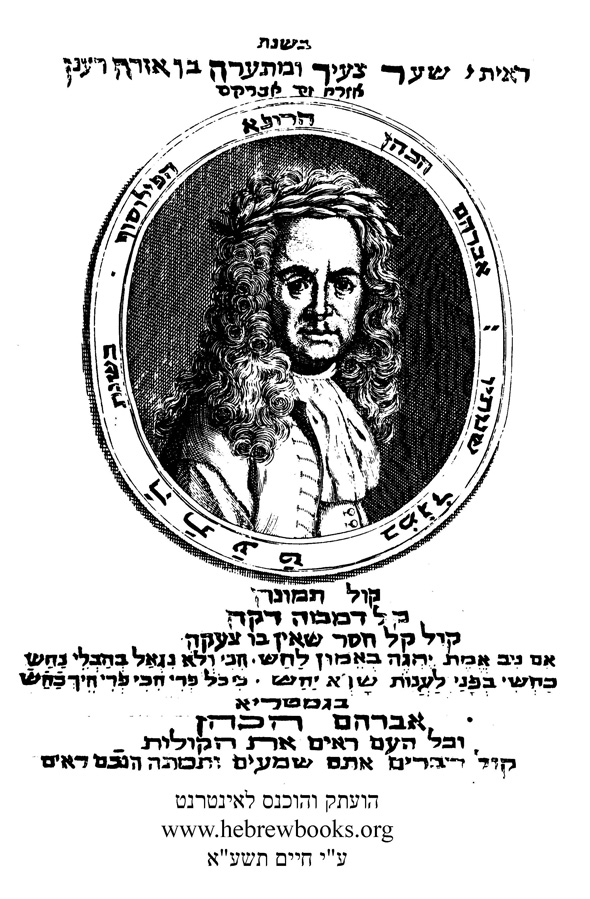
3. In the previous post I mentioned something I was told by R. Avraham Yosef, the son of R. Ovadiah. He is the chief rabbi of Holon and while a great talmid hakham, unlike his brothers R. Yitzhak and R. David he has not published very much. Here is his picture.
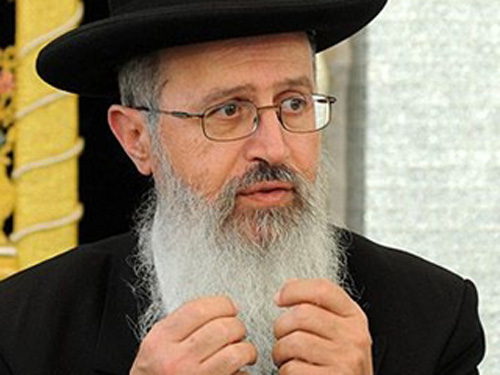
Like his father, R. Avraham is known for some controversial statements. He has also surprised people with his viewpoints. See here, for example, where he expressed his support for Livni becoming prime minister. I have found that he is very accessible and will answer any letter written to him. Since we are approaching Passover, let me share with readers the following.
From reading the works of R. Ovadiah Yosef,[20] I have always assumed that in his opinion even Ashkenazim living in Israel are obligated to follow R. Joseph Karo. Despite what R. Yitzhak states in his letter published below, I haven’t seen any convincing explanation as to why the Moroccans and the Yemenites should be obligated in this according to R. Ovadiah, but not the Ashkenazim. And yet R. Ovadiah does not say so openly, perhaps to avoid involving himself in controversy. He also doesn’t say that Ashkenazim should keep their practices in the Land of Israel, except for one issue, namely, kitniyot, where he is explicit that Ashkenazim are obligated to follow their tradition.[21] However, based on my assumptions from reading R. Ovadiah, I assumed that the obligation of kitniyot in the Land of Israel only applied to those who identified as Ashkenazim. If, on the other hand, someone wanted to “convert,” as it were, to Sephardi practice, he would no longer be obligated in kitniyot.
To test my theory, I wrote to three of R. Ovadiah’s sons, R. David, R. Yitzhak, and R. Avraham, asking if it was permissible for an Ashkenazi to adopt Sephardi practices in all areas, meaning that he would no longer have to avoid kitniyot. R. David never replied, but I did receive replies from R. Yitzhak and R. Avraham. Readers might recall how R. David and R. Yitzhak differed about what blessing should be recited over Bamba, and each claimed to have the support of their father. In the kitniyot case as well there is a dispute. R. Yitzhak wrote to me that an Ashkenazi, even in Israel, is bound to his communal practices. The only exception is if he is a baal teshuvah., In this case, he hasn’t yet adopted the Ashkenazic practices, and he can therefore “become Sephardi”. Here is R. Yitzhak’s letter (it was one letter, with two signatures).
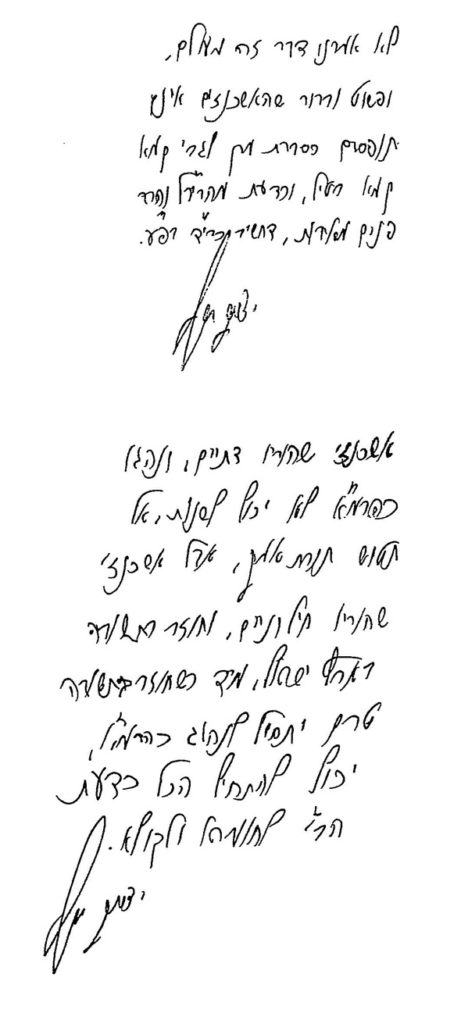
However, R. Avraham has a different perspective, believing that he too is properly representing his father’s outlook (and what he writes is what I also assumed based on my own reading of R. Ovadiah). According to R. Avraham, an Ashkenazi in Israel (and only in Israel) is permitted to become Sephardi, בין לטוב ובין למוטב. Here is R. Avraham’s letter.
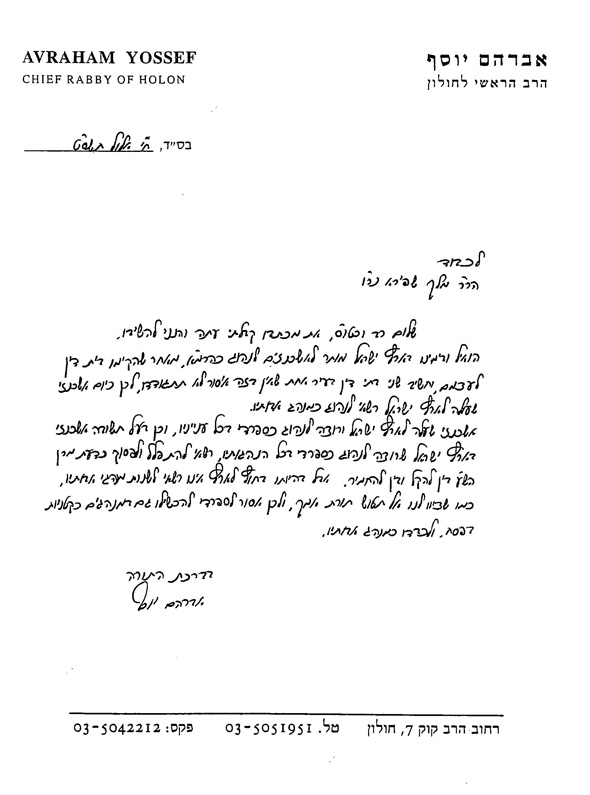
4. Rabbi Moshe Shamah’s commentary on the Torah has recently appeared. At over one thousand pages, it is titled Recalling the Covenant: A Contemporary Commentary on the Five Books of the Torah. In a future post I hope to deal in more detail with one of Shamah’s essays, but in the meantime I wanted to let readers know about the book’s appearance. Many volumes of Torah commentary appear each year, usually written in the same style. Shamah’s book is different. The sources used and the questions asked will be eye-opening for many. It is not derush and does not psychoanalyze biblical figures. Rather, Shamah’s book is high level Torah scholarship in the tradition of the great peshat commentators, both medieval and modern,. I also found it interesting that the book contains a blurb from the noted biblical scholar Gary Anderson (as well from Yaakov Elman, Barry Eichler, and Jack Sasson).
Just as I was about to send in this post I also received Rabbi Nathaniel Helfgot’s just published Mikra and Meaning: Studies in Bible and Its Interpretation. This is a collection of essays on different themes in Tanakh and is a good example of the Modern Orthodox revolution in the study of Bible. Just as the Rav commented that that it would be impossible today to (successfully) teach Talmud to students who are secularly educated if not for R. Chaim’s approach, something similar can be said regarding Tanakh. For those with a secular education, who have read great books, it is very difficult to connect to Tanakh without the new approach that has been developed in the last forty years or so. As R. Yoel Bin Nun puts in his preface to Helfgot’s book: “It is impossible to study Tanakh in the land of Israel as if we are still residing in Eastern Europe prior to the Holocaust.”[22]
[1] There are, to be sure, opposing passages. See e.g., Bamidbar Rabbah 10:17, where it records that Manoah stated: והנשים אינם בנות הוראה. This text is cited by a number of halakhists to show that women are not to issue halakhic rulings. Both R. Hayyim Hirschensohn, Malki ba-Kodesh, vol. 4 p. 104 and R. Yissachar Tamar, Alei Tamar, Zeraim, p. 151, reject drawing any conclusions from the passage. Both of them claim that one can’t rely on what Manoah said, as he was an am ha-aretz (see Berakhot 61a: מנוח עם הארץ היה). This is an interesting point, but I wonder if it has any validity. It obviously depends on how one is supposed to read Midrash. On the one hand, Manoah may have been an am ha-aretz, but the sage who put this expression in his mouth was not, and neither was the redactor of the text, so perhaps Manoah’s statement should indeed be seen as a rabbinic position. On the other hand, since it was put in the mouth of an am ha’aretz, perhaps it should be regarded as simply that, namely, an uninformed opinion.
It is interesting that the well-known author, R. Aaron Hyman, responded to Hirschensohn in Malki ba-Kodesh, vol. 6, p. 204. He criticized Hirschensohn for writing as if he believed that because the Midrash quoted a statement of Manoah, that the historical Manoah actually said this:
ומה שמביא חתנו הלשון מבמ”ר נשים אינן בנות הוראה, ורוצה אדוני לתלות יען שמנוח ע”ה הי’ אומר דבר זה, חס מלהזכיר שיאמין כבודו שבאמת מנוח אמר דבר זה, האם אמרו חז”ל מדברי נביאות או בקבלה, הלא אך בדרך דרש אמר הדרשן כן וכן והוא דברי הדרשן הי’ מי שהי’ אבל מדרש הוא ואדם גדול קבצם, וכן ידוע כל השקלא וטריא שהיה בין קרח ומשה בענין טלית שכלה תכלת והאלמנה והכבשה, זהו אך מליצה נשגבה אבל לא שבאמת היה כן.
See Hirschensohn’s reply, ibid., p. 209, that his intent was only that the Midrash, בדרך דרש, attributed words to Manoah.
[2] Another irony is that the halakhic textbook written by the most distinguished of these yoatzot turns out to be more stringent, and requires consultation with rabbis more often, than halakhic texts written by men. See Aviad Stollman’s review of Deena R. Zimmerman’s A Lifetime Companion to the Laws of Jewish Family Life in Meorot 6 (2007), p. 5. I can’t imagine that women think that there is an advantage in having halakhic works written by other women if these works actually reduce female autonomy in intimate hilkhot niddah matters and require more consultation with male rabbis.
With regard to calling the women yoatzot and not poskot, Stollman, p. 8, n. 20, believes that “this is merely a tribute to Orthodox political correctness.” Maybe someone who knows the situation better than I can comment on Stollman’s point. That is, are these women really giving halakhic decisions and merely “covering” themselves by using the politically correct term yoatzot?
Regarding Stollman, I should point out that he is an academic scholar, and in addition to articles has published a critical edition and commentary of Eruvin, ch. 10, Ha-Motze Tefillin (Jerusalem, 2008). He has also published a volume of responsa, Pele Yoetz (Jerusalem, 2011). Responsum no. 45 is, I think, unique in responsa literature. Stollman was asked if it is permitted to create Santa Claus dolls that sing Jingle Bells. He rules that it is permissible. If I’m not mistaken, Stollman is the first one since R. Jehiel Jacob Weinberg to combine academic Talmud study with the writing of halakhic responsa.
Returning to yoatzot, I think many will find interesting that in Yemen and in some of the Sephardic world there was never a concept of asking a rabbi intimate niddah questions. This was because the women were embarrassed to do so, seeing it as “untzniusdik”. I mention this only because I have heard rabbis say that in truth there are no tzeniut issues with this, and women shouldn’t be embarrassed. They make it seem that it is only due to modern values that all of a sudden this sort of thing is uncomfortable for women. This is clearly not the case, as we see from what happened in the Yemenite and some of Sephardic worlds, hardly centers of modernity. (I am only speaking of the historical reality, not the wisdom of the Yemenite and Sephardic approaches, which usually meant that any doubt would be assumed to render the woman impure.) R. Yitzhak Shehebar, the Sephardic rav of Buenos Aires, writes as follows in his Yitzhak Yeranen, no. 95 (quoted in Beit Hillel, Tamuz 5769), p. 120:
ואשר לעניין מראות הדמים לא נהגנו בזה כלל, כי מעולם לא ראיתי להרבנים באר”צ [ארם צובה] שטפלו בזה, אך הנהיגו את הנשים שכל מראה הדומה למראית אדמומית שהוא טמא, זולתי אם יהיה כמראה לבן או ירוק שהוא טוהר.
Regarding Yemen, R. Yitzhak Ratsaby writes (Piskei Maharitz, vol. 3, section Be’erot Yitzhak, pp. 339-340):
אצלנו בק”ק תימן יע”א אין שואלין כלל לחכמים בעניין הכרת מראות הדמים, ובכל ספק הנשים מחזיקות עצמן טמאות ויושבות ז’ נקיים [ואפי’ לבעליהן נמנעות מלהראות כדי שלא יתגנו בעיניהן . . .] וכ”ה גם ברב ק”ק ספרדים יע”א . . . האידנא דהשאלה בדרך כלל היא רק לעיתים רחוקות, עי”ז נשתלשל הדבר שנמנעו מלשאול לגמרי מחמת בושתן היתירה וצניעותן המרובה כנודע
Ratsaby points out that this practice developed even though talmudic literature provides plenty of examples showing that in the days of the tannaim and amoraim the Sages did examine ketamim.
Regarding Yemen, see also R. Nachum Eliezer Rabinovitch, Siah Nahum, no. 60. In this responsum, Rabinovitch supports the institution of yoatzot and suggests that this practice, of turning to women in niddah matters, even existed in tannaitic times: כי לפנות לאשה חכמה אין חשש שמא תתגנה
In a note to this responsum, the editor provides further testimony about Yemen.
שמעתי עדות מחכם נאמן, שהיו מקומות בתימן בהם היו זקנות שהיו מוחזקות כבקיאות בעניני מראות, והנשים היו פונות אליהן, ומעולם לא ערער אדם על כך.
R. Moshe Maimon called my attention to the Meam Loez’s discussion of the laws of niddah, addressed to both men and women, and there is no mention there of bringing anything to the rabbi. This omission was rectified by R. Aryeh Kaplan, who in his translation (vol. 1, p. 136) adds: “When in doubt, a competent rabbi should be consulted.”
[3] Mishpetei Uziel, Hoshen Mishpat, no. 5.
[4] For sources on women deciding halakhic questions, see the three responsa in support of Sara Hurwitz’ being ordained as a “Maharat,” authored by Rabbis Yoel Bin-Nun, Daniel Sperber, and Joshua Maroof, available here.
[5] The Hafetz Hayyim, who was a “rabbi” if there ever was one, only received semikhah when he was 85 years old, and that was to satisfy a bureaucratic requirement. See Moshe Meir Yashar, He-Hafetz Hayyim (Tel Aviv, 1958), vol. 1, p. 19. According to R. Isaac Abarbanel, rabbinic ordination as currently practiced arose due to Christian influence. See Nahalat Avot, beginning of ch. 6:
אחרי בואי באיטאליאה מצאתי שנתפשט המנהג לסמוך אלו לאלו. וראיתי התחלתו בין האשכנזים כלם סומכים ונסמכים ורבנים. לא ידעתי מאין בא להם ההתר הזה אם לא שקנאו מדרכי הגוים העושים דוקטורי ויעשו גם הם.
[6] The title “rabbi” is indeed significant. This can be seen by the fact that when Sara Hurwitz was called Maharat there wasn’t any outcry, but when she was given the title “rabba” that is when the controversy really broke out, even though her job description didn’t change in the slightest. Does this mean that there was no objection to a woman functioning as a rabbi as long as she didn’t have the title? Only after she was renamed “rabba” did the RCA adopt a resolution rejecting the “recognition of women as members of the Orthodox rabbinate, regardless of the title.” Yet despite that resolution, there are synagogues where women are still serving, for all intents and purposes, as members of the rabbinate minus the title.
[7] Similar, though not identical, perspectives have recently been offered by Rabbis Norman Lamm, Michael Broyde and Shlomo Brody. See Broyde and Brody, “Orthodox Women Rabbis? Tentative Thoughts that Distinguish Between the Timely and the Timeless,” Hakirah 11 (Spring 2011), pp. 25-58. None of them reject the notion of Orthodox women rabbis at some time in the future. From speaking to many people, my own sense is that a majority of the Modern Orthodox community supports women rabbis (although not necessarily pulpit rabbis). When I say “support,” I mean if asked the question, the reply will be yes. But at the same time, the overwhelming majority of the Modern Orthodox world doesn’t care about this issue at all, and this includes women also. However, I believe that the minority will continue to push this issue, and when women rabbis become a reality, the Modern Orthodox will not reject these women or the congregations that employ them, as we can already see at present with Rabba Hurwitz and other female synagogue rabbis (in everything but name). I think this will happen before the natural development of female poskot who, as already indicated, will by definition be rabbis even without a formal ordination.
One more point that needs to be mentioned with regard to women rabbis is the issue of economic fairness. There are significant tax savings, due to parsonage, that an ordained clergyman receives from the government. While it is true that R. Michael Broyde has written that even women teaching Torah are eligible for this even under current tax laws (see here) and a prominent New York law has firm also expressed this opinion, many yeshiva day schools, acting under the advice of their accountants, have refused to adopt this policy. Some sort of formal ordination for women would settle the parsonage question, and give a financial boost to many of our underpaid teachers.
[8] There are, however, a number of very good articles on halakhah written by women. See e.g., Devorah Koren’s article in the recently published Milin Havivin 5 (2011), available here.
[9] Regarding Lieberman, I would like to call readers’ attention to what appears in the latest Yeshurun, vol. 25. On p. 21 the following footnote appears:
“How Much Greek in Jewish Palestine לגרסאות ופירוש תיבות אלה, ראה דברי הגר”ש ליברמן “
Here Lieberman is given the title due a gadol be-Yisrael. Perhaps this can be seen as making up for the censorship of references to Lieberman (and Louis Ginzberg) in an article by R. Mordechai Gifter that appeared in an earlier Yeshurun. See Saul Lieberman and the Orthodox, p. 32 n. 117. After my book appeared, I was informed by one of the editors of Yeshurun that the censorship of R. Gifter’s piece was carried out by the one who prepared the article for print, and the editors knew nothing about this and were upset when they learnt what had occurred.
On p. 632 of the new Yeshurun there is a letter from R. David Zvi Hillman to Prof. Shlomo Zalman Havlin in which he states the following: In the early volumes of the Encylopedia Talmudit Lieberman was referred to as ר”ש ליברמן, a point I noted in Saul Lieberman and the Orthodox. Yet American rabbis protested and insisted that he not be mentioned. These rabbis are identified with the Rabbinical Council of America: מהסתדרות הרבנים ר”ל המזרחניקים. In response to this, R. Zevin from that point on only mentioned the name of Lieberman’s books but not Lieberman himself. A Bar Ilan search reveals that vol. 13 is the last volume where ר”ש ליברמן is mentioned. (Vol. 15 was the last volume to appear in R. Zevin’s lifetime. See Zevin, Ishim ve-Shitot [Jerusalem, 2007], p. 40 [first pagination]).
Why would R. Zevin agree to this? The answer is obvious: money. The Mizrachi in America was an important source of funds for the Encyclopedia Talmudit.
[10] The term “rabbanit” was primarily used for the wife of a rabbi. See Robert Bonfil, Rabbis and Jewish Communities in Renaissance Italy, p. 77 n. 186. My point is only that it was also used for scholarly women.
[11] The continuation of the shiur is also of great interest, as he explains that if one ends up in a hotel on Shabbat and sees that the lights in the hall go one every time one leaves one’s room, it is still permissible to walk in the hallway and it is not even regarded as a pesik reisha.
[12] See the biography and picture of her here. For pictures of Flora and her family, see also here.
[13] Rivka bat Meir of Prague (died 1605) was another learned woman who was called “rabbanit”, see Frauke von Rohden, ed. Meneket Rivkah (Philadelphia, 2009), pp. 6-7. Rivka authored the Yiddish mussar work Meineket Rivka, published in Prague, 1609. On the title page she is referred to as הרבנית הדרשנית . (In the Altneuschul memorial book it also says that she preached. See Von Rohden, p. 6) Here is the first page of the book, where she is again referred to as “rabbanit”.
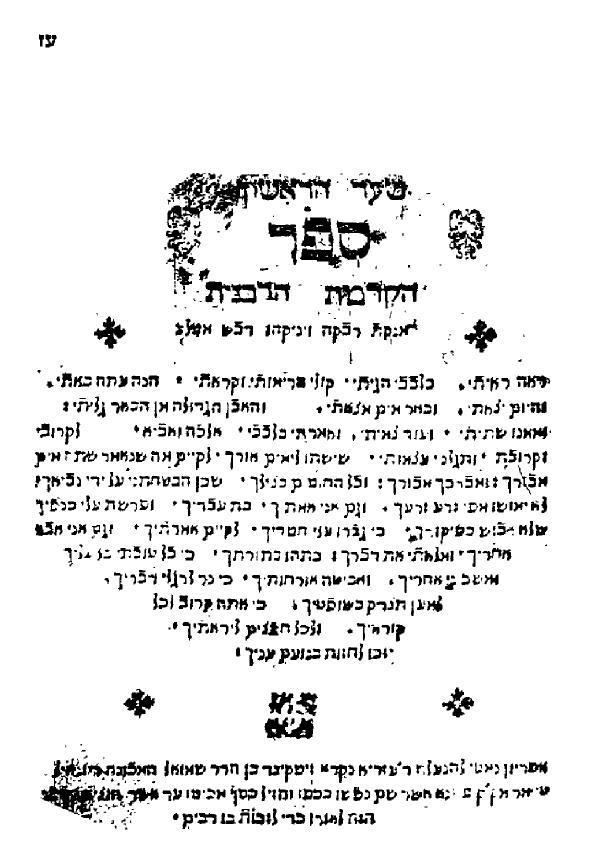
Lest anyone misunderstand, I must stress that Rivka only served as a rabbi and preacher for other women, and was therefore not a prototype for twenty-first century women rabbis. My point in referring to her is to highlight the use of the term “rabbanit” as designating a learned woman.
[14] Teshuvot Pesakim u-Minhagim, vol. 2, ed. Kahana, nos. 155-156.
[15] See Daniel Sperber, Minhagei Yisrael, vol. 1, pp. 65-66.
[16] I originally wrote Levinsohn, and thank a helpful reader for the correction. Loewisohn’s essay originally appeared in his posthumously published Mehkerei Lashon (Vilna, 1849).
[17] Incidentally, the note as it appears in the Vilna Mishnah has also been altered from what appears in the original work. In the original it states אשר אינם על טהרת לשון עבר, and in order that people understand what Loewisohn was saying, these words were altered to read: אשר המה כפי תכונת לשון הארמי
[19] See here. As one of the commenters pointed out to this post, the women appear to be mermaids. He helpfully provided this link.
[21] See Yabia Omer, vol. 5, Orah Hayyim no. 37, Yehaveh Da’at, vol. 1, no. 9, vol. 5 no. 32.
[22] R. Aharon Lichtenstein also has a preface to the book, where his ambivalence about the new approach comes through very clearly. This short essay deserves its own analysis.
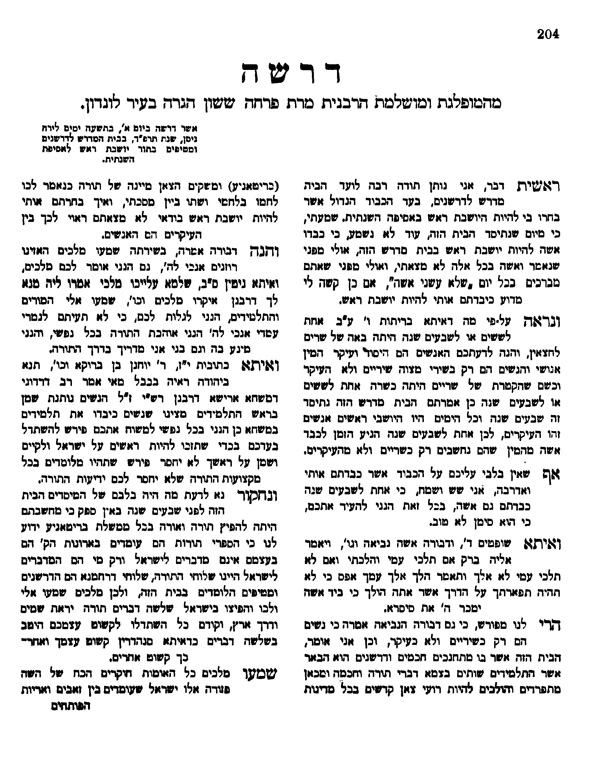
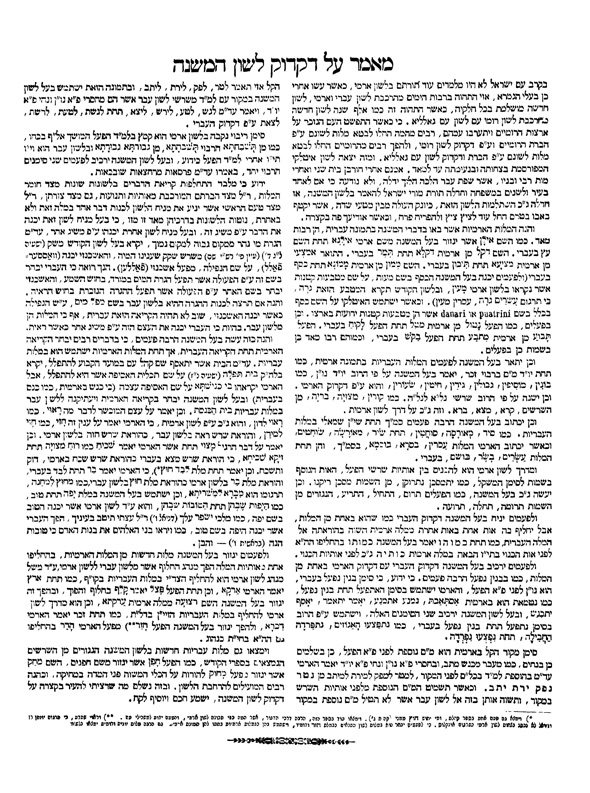
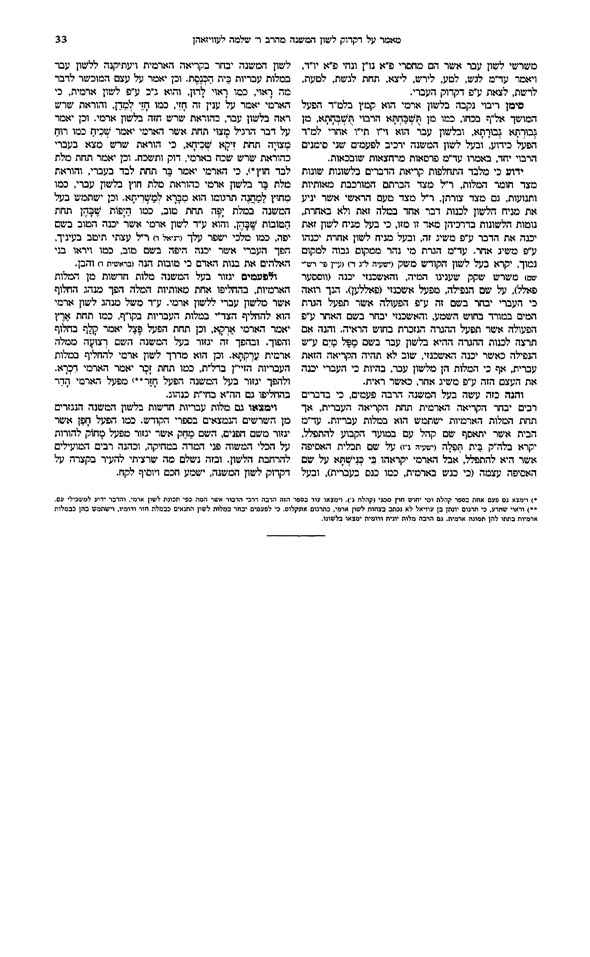

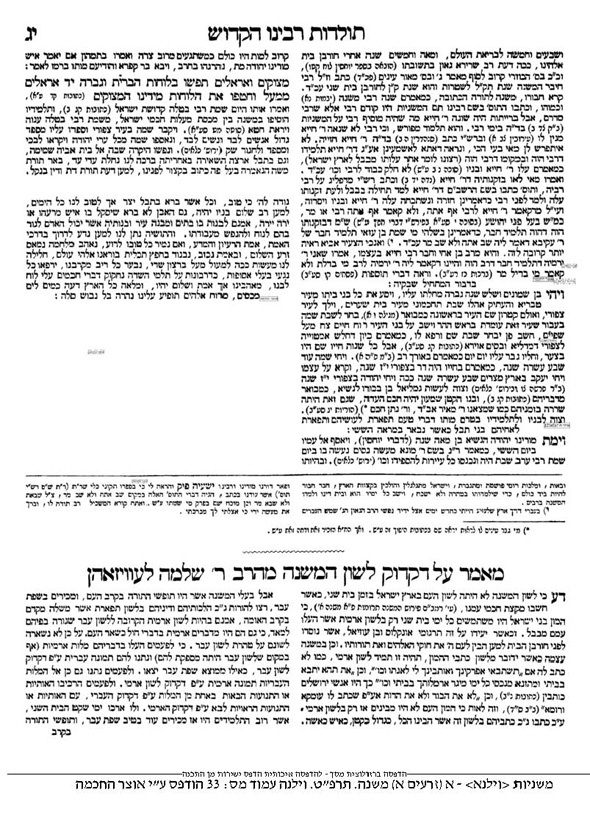



69 thoughts on “Answers to Quiz Questions and Other Comments, part 2”
Hi Marc,
Why can't we say that the use of the term rabbanit means rabbinical (as in a woman with great knowledge like a rabbi) as opposed to an equivalent to the title rabbi? Hasn't the term rabani been used for male non-rabbis who were nonetheless learned?
Also, have you come across the name Osnat Barzani? She was a Kurdish rabbinical scholar who was called tana'it.
Anyway, kol tuv. I hope to see your book on censorship out soon.
Bar Ami
Hello Marc.,
Great post. Two things – First pf all, in regard to Rabbanit, I waswondering if you have any information on this person and authorship. Its brought down in my family, as we are direct descendants of the Ma'haral, legends about his daughter, Chava. What's known is that she was married to R' Refoel Katz, who died young, and got remarried into the Bachrach family. Her grandson was R' Chaim Yair Bachrach, the Chavos Yair (named after her). According to the legend, she was extremely learned in many different parts of torah. As the legend goes, during her lifetime the Matnos Kehuna on Midrash Rabba was published, and that year she published a negating work against manyof the things he wrote. He supposedly admitted, in a public venue, that wherever she argues, she is right and he is wrong.
In reference to your question of whether Ashkenazim can change their Mihagim to Sphardim, see She'elos Utshuvos Ginas Vradim (Avraham b. Mordechai Halevi, contemporary of the Rosh) pp. 124 in קושטנדינא 1716, Yoreh Deah r.3, p. 5. He asserts that in most cases , a German – Ashkenazic native is not only supposed to take on Minhagim of Spain on visits, but in most cases, even dealing with the smallest of intentions to stay for some period of time, the Kulos are also fit to be accepted. Each one of the Rabbi Yosef's seem to find a different way to make this assur. Why is this?
Interesting point. We would need to investigate if the term rabani was used in the time of the Hida and before him to describe a learned man. But in the end, it is not that important, with the Hida and others we do find women being given a quasi-rabbinical title. Furthermore, when the Hida has a seciton for women whom he terms "rabbanit" this is in contrast to all the men in the book whom he terms "rabbi".
But thanks for this point which I need to look into. And yes, I have heard of Barzani.
Interesting post, but the sources are not really relevant. You can give someone whatever title you like; the question is, what does it signify. Calling a woman "rabbanit" with the sole intention of honoring her scholarly acheivements is fine. Useing the same title to attempt to shoehorn her into a social position which her community is not willing to grant her is something entirely different. None of the earlier rabbanits were "ordained" with the intention of pushing a social agenda, and there were no protests againt them. As long as the general feeling is against the "equality" that is being proposed, the title with its very deliberate associations will be rejected. This does not mean that it will not change in the future; but it definately is not there now.
As for women with sefarim, R' Shurkin has an interesting story about a woman's (unpublished) sefer in his Meged.
A more positive view on women as sandek is in Kupfer's Tes. U'Pesakim M'Chachmei Tzarfat no. 71. Also note in Klallei HaMilah L'R Yaakov Hagozer, he specifically has the mother be a kvatter, not sandek.
As for the pictures in section 2, I don't see why you keep making a fuss over this kind of thing. For whatever reason that the pictures are there in the first place, there are people now who feel that they are not appropriate. As such, they do not want to be responsable for distributing them. Of course, it would make more sense just to skip the page and not do a poor job covering up. After all, the point is to make the sefarim available, not the pictures on the title page.
As for number 3, without casting any doubt on the halachic impartiality of the Rabbis Yosef, I wonder how may Ashkenazi rabbonim would concur, and what they would say in the opposite case. I think that the issue was discussed in the early and mid achronim, and the split was there.
rashash b'k 15a
Is there no issue published on this blog pictures or figures which are deemed lewd? If it was for teaching purposes that would be OK, but simply to show that it has been done in history? Moreover, perhaps we should praise our generation for being more sensitive to צניעות and these images do not get published?
Aside from this, very interesting and informative post!
I find the whole notion of "female" perspectives on halacha silly. There is good and bad halachic reasoning. Males can engage in bad halachic reasoning and women can engage in terrific halachic reasoning. There is nothing male or female about good arguments — unless one wants to claim that reason itself is male, in which case any kind of normal discussion breaks down.
I'm sorry, I have to take strong issue with some things here. I think you give yourself away when you write:
"I can’t imagine that women think that there is an advantage in having halakhic works written by other women if these works actually reduce female autonomy in intimate hilkhot niddah matters and require more consultation with male rabbis."
You seem to be implying that "progess," in your eyes, in good inasmuch as it agrees with your point of view. Did you never consider that Zimmerman may be stating what she sees as, well, actual halakhah? If you call for some change, you'd better be prepared to take all that that implies.
And related to that we find what may be the most frightening part of your post: Your references (at least two) to some new "perspective" women may bring to halakhah. God help us if that's the case. I have no problem with women "paskining." But rules and laws are what they are, and it would be best if special "perspectives" are left out of it. Down that path lies Sotomayor's "wise Latina."
In any event, part of your overall strategy over the years is revealed in your reaction to R' Schachter's line. Of *course* a solitary reference is "inconclusive." That's the nature of the beast.
Finally, why are you "certain" the Rama would object to a female chazan more than a sandak? A sandak involves certain body parts, as you know.
Random points:
-Ah, "rappa" is from "raven." (Or so it was thought.) So much for the modern myth of "doctor," kind of hard to explain for kohanim, at least if we're going to be anachronisitic about halakha. (I always thought it was from a town in Italy, a port, though.)
-Speaking of urban legends, why do you take one (very biased- note the "r'l") witness that RCA members weren't happy with Lieberman? I'd have to see a lot more evidence than that. More likely, it had to do with Zevin. Any references to Lieberman's works without his name in volumes 14 or 15? How involved was Zevin with them? Find more evidence before you start libeling the RCA and/or Mizrachi.
-I'm not surprise you didn't get a response from David Yosef. He's in hiding, last I heard. 🙂
– One wonders what the response would be if you asked if a Sephardi could become an Ashkenazi in, say, the US. (Or, better, Germany.) Not a chance… (By the way, the Israel argument is a bit troubling- it's not as if there were no Jews when the Sephardim showed up.)
-As you well know, lots of people kept on believing in Shabtai Tzvi for years.
I find it ironic and not a little ridiculous that the same authorites who tend to outlaw women being sandakaot, because of 'tzniut', are unbending on the 'yoazot' issue, believing that only men are competent to deal with the most intimate issue of niddah…
If you're looking for a full-fledged halakhic work in Hebrew by a woman, I'd suggest Rachel Levmore's מנעי עיניך מדמעה on premuptial agreements. It was published by the Young Israel here in Israel; a friend of mine who worked there told me he received a call from a dayyan who wanted to be able to cite it but needed to know the name of the Rav who had 'really written it for her' and was incredulous when told she had written it herself.
As for yo'atzot, they and the to'anot rabbaniyot in a sense are mirror images of possible outcomes of the revolution on women's Torah learnind, i.e. the latter challege rabbinic authority while the former reinforce it.
I noticed that the 'mara'aot' issue has recently come (this isn't the first time) under the spotlight (no pun intended) in the non-Jewish media. See the recently published memoir by Miriam Feldman, where she lambasts the practice of Rabbis (always male) examining women's undergarments as 'disgusting'.
You wrote
least two) to some new "perspective" women may bring to halakhah. God help us if that's the case. I have no problem with women "paskining." But rules and laws are what they are, and it would be best if special "perspectives" are left out of it. Down that path lies Sotomayor's "wise Latina."
I see I will have to do a post on this. As I understand it, pesak is an art, not a science. Everyone brings perspectives to the table.
Re. Zimmerman, the entire justification for the Yoatzot system is that it makes these matters more user friendly to women. If the result of yoatzot's book means that you have to go to the male rabbis more than before the yoatzot came on the scene, then why does anyone need them to begin with?
Regarding the peritzut of a female sandak, it has nothing to do with her seeing the male body part (she changes male baby diapers). It is that she is brought into the men's seciton of the shul. But I can't see how anyone would deny that a woman leading the davening is more peritzut than a woman coming into the shul for a berit, which the Maharam tells us was the standard practice before he could reverse it.
And regarding my "reaction" to R. Schachter's point — look again. I have no reaction.
<span><span>Halakhic decision-making is an art, not a science. It is about more than just good and bad halakhic reasoning. Outlook plays an important role in deciding halakhah (what I call meta-halakhic factors). Poskim are not computers.</span></span>
If my memory is still correct there is a story in the Ba"H's (Joel Sirkes) introduction to the Tur. The story is about how his wife taught Halakhah or corrected the learning of students in her husband's beit midrash. Perhaps someone else has the text and can correct my description.
<span>"Everyone brings perspectives to the table."</span>
<span>As individuals in a time and place. Not as a class. Down that way lies "feelings" and Balkanization. </span>
<span>
"the entire justification for the Yoatzot system is that it makes these matters more user friendly to women."</span>
<span>Is it? You seem to imply that it's to give learned women deserved power.
"It is that she is brought into the men's seciton of the shul"</span>
Were britot always in shul? Help me out.
<span>This blog post should really have been split into two.
The second half is interesting scholarship on censorship and related odds & ends. Everyone benefits from this. It is Marc Shapiro at his best.
The first half is just more agitating and agenda lobbying from Marc Shapiro in the area of his own particular obsession, feminism. It's not scholarship, it's just using a computer to dig up obscure or irrelvant source material, and urging massive societal upheavals thereupon. C'mon. WADR, this type of stuff can, should, and will be dismissed.</span>
Seconded. What kind of nonsense is this? When did Marc Shapiro ever write about feminism? Obsession?
<span>This is the first time I have heard that I have an "obsession" with feminism. When have I ever written about this before? Where am I lobbying or agitating? I have never in my life ever publicly spoken about feminism or attended a JOFA conference, There are hundreds of hours of my lectures on Torah in Motion mp3s and you will search in vain there for any "obsession" about feminism. Nor for that matter have I ever attended a "partnership minyan", so I don't know where you you got this impression.</span>
no feminism is not marcs agenda. his agenda can be summed up in two sentences. 1. right wing orthodoxy is wrong for doing all sorts of thing that jews have never done in the past. 2. right wing orthodoxy is wrong for not realizing that we need to do new things that we have never done in the past.
This article is a good example of both!
I believe his point is that we aren't bigger than the Mechabrei Sfarim, why should we be more frum than they were? I've personally handled first editions of Pachad Yitzchaq (R' Isaac Lampronti) and early editions of Maharsha which were more 'lewd' (you're language, not mine) than the posted pictures.
let's say, but this has to do with seforim.blog how? Unless you agree it doesn't but the site in itself is a platform for any of Prof. Shapiro's thoughts even unrealted to seforim?
<span>What can I tell you? I can't please everyone all the time. I have a few different types of posts. One is heavy on unusual bibligraphical points and unusual and often unknown aspects of Jewish hsitory. Another deals with aspects of Jewish theology (e.g., my posts on R. Kook and Torah mi-Sinai). Others, touch on contemporary issues and controversies, but as with all my posts, by using a variety of seforim and works of Jewish scholarship. From the emails I receive, I know that each of the styles has its own fans (as well as those who prefer the others).
I myself am much more interested in discussing historical points, and have no desire to argue about the direction of Orthodoxy. There are loads of sites where people can do that. The most I will do here is sometimes express an opinion (but usually not) and that is all, and I think that is OK and does not detract from the site. You can agree or disagree but that is not what is important, as I am not trying to convince anyone about "existential" matters.
I have posts in the works in all three of my interests. I plan on dealing with aspects of Lithuanian Jewish history and some arcane stuff found in seforim. I also have to continue my series on R. Kook's new writings. I have more to say on Torah min Shamayim as I look at two new books that have appeared, and I will return to my discussions of historical accuracy in the Bible. And finally, I plan to deal with haredi views of society and will argue that internal literature of the Israeli haredi world shows that the goals of some is the creation of an Iran-like theocracy. I will also bring surprising sources regarding the Taliban women.</span>
<span>
I don't know yet which post will be next.</span>
I will answer once more and leave it at that.
I do like to add sociological comments that I think arise from the matters in the books I discuss. E.g., the women's issue at the beginning of this post. I didn't set out to write on this, but when I did the last post on women's singing (people wanted me to write on this) I saw that the passage I referred to from Kohelet Rabbati also mentioned female dayanim, so I figured why not examine this issue as well. Those who read the posts know that there is no set pattern, but the posts flow organically depending on what I am discussing. And once I was discussing the women's issue, I also made a few sociological comments (and why not? Last I looked sociology was an academic dept.) But it is not like I set out to write on the women's issue per se (not that there is anything wrong with that). Everything was directly tied to the previous post.
And so I will continue. (I forgot to mention that I will also be dealing with the book Torat ha-Melekh one of these days.)
I would say paskening is a mixture of art and science. Either way, I don't believe in the existence of "male" and "female" perspectives. (Is "Atlas Shrugged" a "female" novel? Did Condeleeza Rice have a "female" approach to going to war in Iraq?)
I think female poskim would basically cover the same spectrum of approaches that male poskim cover (some machmir, some meikil, some imaginative, some not, some daring, some not, etc. etc. etc.).
I am not saying you're wrong. What I wrote is that it will be interesting to see IF a feminine perspective affects how halakhah is decided. R. Be'eri, whom I quoted in the post, thinks it would
"<span>I will answer once more and leave it at that"</span>
I completely agree.
Ha'yotzei me'hana"l (mi'dvarecha) at the end of the day not all your posts are related to seforim.blog. Ok. That's fine. I guess in the future we shouldn't expect posts particurly dealing with Torah topics (scholarly geared that is, of course). Sure sociology is an academic dept., but hey, so is sedimentology and probably Cokeology too. Yes, you have thoughts on many diverse topics but not to dodge the main point – not all of them have to do with the keyword seforim.blog. You might be stretching the scope of this comment (salka datach a'ha kai? A'ha kai). Noone is saying you shouldn't stop writing and noone is questioning what you write. We were just noting that sometimes some of your posts have little – to say the least -to do with seforim. More like questioning their place. Like you said, there's plenty of other sites who blog about these ideas. Talking about cherry-pie and qouting some obscure seforim just doesn't make it into a shtikle Torah. Sorry.
In any event, eagerly looking foward to your comments on Torat Ha'melech. Those should be more promising. Keep 'em coming.
@ H Handler
See the introduction of the Ben Prisha to the Tur where he describes his mother.
Prof. Shapiro:
Regarding ROY's position on Ashkenazim in EY, see Sefer Kelalei Hora'ah from R' Yitzhak Yosef (printed in the back of vol. 1 of the original editions of Shu"t Yehave Da'at), and in Kelale Maran Sheulan Arukh, no. 10 he states clearly, "An Ashkenazi who is lenient in EY in accordance with Maran, against the Rama, has what to rely upon. <span> Nevertheless, it is good and proper that even in Eretz Yisrael they should follow the Rama</span>."
I'm not sure where you get this idea that Rav Ovadia indicates that Ashkenazim are obligated to follow Rav Yosef Karo in EY. Even the letters from R' Yitzhak and R' Avraham above do not give that indication at all, but rather are open the possibility of it being permissible to follow Maran. I have been through hundreds of teshuvot from Rav Ovadia and I never once saw him write that Ashkenazim must follow Maran against the Rama.
<span><span>I too indicated in the post that he never says that they have to follow R. Joseph Karo. But I said that the implication of things he writes is that this should be his position (and look at the quote you brought, where he leaves open the possibility of following R. Joseph Karo, as he only says that it is good and proper to follow the Rama, not that it is an obligation)
As I wrote in the post, how can one distinguish the Yemenites and Moroccans from the Ashkenazim? Regarding the first two, he claims that when they came on aliyah, even though they came as whole communities, they are now obligated to follow R. Joseph Karo (a point both groups reject). This is because R. Joseph Karo is mara de-atra of Eretz Yisrael. The aliyah of the Ashkenazim, beginning a couple hundred years ago, was no different.</span> </span>
<span></span>
<span>See R. Yitzhak, Benei Morocco ve-Hilkhoteihem and also his Benei Teman ve-Hilkhoteihem.</span>
<span></span>
<span>If you can explain the difference, I would be grateful.</span>
I have no information and I am certain that she never actually wrote a book. I have no idea why R. Yosef's sons don't stand up for the authority of Maran (R. Joseph Karo) in the Land of Israel
I'm with Nachum re the RCA's supposed objection to referring to Saul
Lieberman as "Rabbi." It seems to be libel on the RCA, Mizrachi, and Rav Zevin. Considering how the Rav referred to Rav Lieberman in such laudatory terms, and how the Rav determined pretty much everything in the RCA and Mizrachi, it all sounds very very dubious.
It does need to be investigated further, but we do have the fact that after vol. 13 Lieberman is not mentioned by name, and R. Zevin was still the editor of the ET and setting policy. So he made a decision not to mention Lieberman by name anymore. If it wasn't due to Mizrachi pressure, there must have been another reason. I guess we have to ask how reliable Hillman is in this matter. Another point to be considered, were there extremist types in the RCA in the late 1960s and early 1970s who would be so anti-Lieberman? R. David Hollander was not an important player at this time.
there are are a number of books on chabad thought published throuch chabad in israel, written by mrs tzirel levanoni
actually one of the most distributed pamphlets in shuls "sichat hashvua" has a weekly column on the parsha written by her
Although there are gray areas, I think the distinction can be summed up simply that, at the onset, Ashkenazim never accepted the authority of R' Yosef Karo as the final word in halakha. In contrast, Sefaradim throughout the Levant and Arab lands did accept the authority of Maran, though different rabbis argued as to the extent of this authority and how much room was allowed for differing opinions. Even many Morooccan and, to a lesser extent, Yemenite rabbis professed allegiance to Maran.
(The Yemenites appear to be broken up into 2 groups on this issue. See R' Yitzhak Ratsabi's recently published Kuntres Ner Yom Tov, which drew condemnation from many Sefardic rabbis, many of whom are Yemenite, for his unflattering language towards Rav Ovadia. Paranthetically, since you mention that you will be discussing the issue of Taliban Women, R' Ratzabi is one of the major defenders of women who walk around in burkas. He also argues in Kuntres Ner Yom Tov that Yemenite Jews would have been better off spiritually had Operation Magic Carpet never taken place and they were left alone in their homeland, and he attributes this sentiment to the Brisker Rav who considered that whole operation a Zionist ploy to give the impression that they were "rescuing" Yemenites.
I thought David Hollander would be your ultimate defense. Nu? That's one RCA member, not the RCA.
In any event, you didn't respond to my questions above: You said that R' Zevin passed away after 15. Are there references to R' Lieberman's books without his name in 14 and 15? If so, how involved was R' Zevin with those?
Marc: look at the Presidents of the RCA in the late 60s and early 70s. And the Executive VP was Rabbi Israel Klavan. And the Rav made all the major decicions. And they pressured Rav Zevin not to mention Rav Lieberman by name??? Give me a break! Maybe someone did put pressure on Rav Zevin, but not the RCA. Maybe in Israel?
Great post by the way. In particular, I have always been fascinated by R. Moses Kunitz and hope to leam more from you about hm.
It is not my defense. I am just quoting Hillman and trying to understand if there is a basis for what he said.
In vols. 14 and 15 Lieberman's books are mentioned but never his name. By the way, even inf vols. 1-13 the books are often mentioned without the name, but his name is also mentioned often. This changes after vol 13 and R. Zevin was still very involved and setting policy in vols. 14 and 15.
R. Zevin and Lieberman were, by the way, quite close.
Unfortunately, Hillman passed away recently, so we can't get any clarification. I assume there is s kernel of historical truth in the story, but probably impossible now to get to the bottom of it. Another point: R. Leo Jung was a big backer of the Encyclopedia. He was also very friendly with Leiberman and would never have asked R. Zevin to omit the name (Jung was one of the only two Orthodox rabbis to go to a JTS memorial event for Lieberman. Lookstein was another who went).
Marc –
Thanks for another very provocative (are you ever non-provocative? 😉 and interesting post.
Let me ask you – you and some others are so concerned about the censorship of the bare breasted and otherwise revealing images – so perhaps you should adorn your books with them, such vital parts of the Jewish past after all, and not buried somewhere inside, but right in the beginning, on title pages, as they appeared in the past, to rectify the terrible historical crime perpetrated against them? Maybe you should similarly adorn Milin Chavivin of YCT and/or your articles there. Do you think your feminist and female backers would like it? If you say they wouldn't mind, I challenge you to do so then. Consider the gauntlet as hereby having been thrown down!
Another fine essay by Rabbi Shapiro. I would like to suggest looking into editing one sentence. Interpreted one way, it's fine; interpreted another way, it could seem insulting. Here's the sentence: "He is the chief rabbi of Holon and while a great talmid hakham, unlike his brothers R. Yitzhak and R. David, he has not published very much."
The phrase "unlike his brothers" could refer to the phrase afterwards (the "fine" interpretation) or to the phrase beforehand (the possibly "insulting" interpretation.)
I don't know which of Rav Ovadia's sons truly represents his views on the issues you mentioned, but it is obvious which one inherited his penmanship!
You are correct. But all I need to do is take out the comma after "David"
<span><span><span>It would be a good experiment, to see if they would censor me. But believe me, I have no feminist backers. They actually don't like me very much (as I can explain in another post). In terms of being provocative, it's all about keeping it interesting. I could write a detailed post on an obscure bibliographical point, but I think that would put people to sleep. I don't think I try to be provocative, but the things that interest me are, well, provocative.
The sort of things I put on the blog do not lend themselves to to appearing in Milin Havivin (pictures and all). But I can tell you that so far, they have not tried to censor me in the slightest (and stay tuned for a future post in which I describe the censorship that led me to stop writing for Tradition).</span></span></span>
i fully agree with both points of your agenda. Therefore i think we need to realize that in the modern world there is no longer a place for nudity in seforim. (my elementary teachers were also allowed to touch the students, but hey, its a new world.) I also agree that we should look to the past for certain things. ie there were virtually no women in authoritative halachic positions, so lets keep it like that.
1. He could have confused the Histadrut, Agudat, and Iggud HaRabbanim. Or individuals with organizations. He's certainly confused the RCA and the Mizrachi.
2. Correlation vs. causation. If the sefarim are mentioned without a name in 1-13, lack of a name in 14-15 means nothing. It could be a coincidence.
Or turn the first comma into a semicolon.
Don't I remember you once complaining over dinner that JOFA hadn't invited you to participate in a panel on R' Weinberg?
Actually, I submitted a proposal to speak (thinking it was an academic conference since I saw the call for papers at the AJS) but they turned me down. I learnt then that what they wanted at their conference was, much like EDAH, a group of people preaching to the converted. My paper was going to argue that the methodology of Orthodox feminism was a complete break with what had been the practice until then, and that therefore it is questionable if the word "Orthodox" can even be applied to it. My book on Weinberg had just come out and it was one of the few books JOFA was selling it at the conference (since Weinberg is so important to Orthodox feminsim due to some of his teshuvot). At the dinner (which I don't recall) I probably said that it was ironic that the book on Weinberg was being touted at the conference but the author of the book was not welcome.
Marc – many thanks, once again, for another facsinating post! I'd be very interested to read the paper you intended to present at the JOFA conference. Is it available anywhere?
<span><span><span>Haggadah Shel Pesach Hamburg 1731</span> </span></span>
<span></span>
<span><span>http://digitalgallery.nypl.org/nypldigital/dgkeysearchdetail.cfm?trg=1&strucID=597076&imageID=1244021&total=1&num=0&word=hagadah&s=1¬word=&d=&c=&f=&k=0&lWord=&lField=&sScope=&sLevel=&sLabel=&sort=&imgs=12&pos=1&e=w</span></span>
That was exactly your point. This was at AJS in Boston- a few of us went out.
Hope I'm not repeating comments already said, but Rabbis Lieberman and Zevin taught together at the Mizrachi Teacher's Seminary, Rabbi Zevin refers several times in his books to Rabbi Lieberman as hagaon (sorry, can't give specific references at the moment) and reviewed his Devarim Rabba in Soferim veSeforim. The idea of Mizrachi threatening to withold money is a bit peculiar, though not impossible, as Rabbi Lieberman's father in law, Rabbi Berlin, was the head of the Mizrachi and lived in the US for years. While he was no longer alive when the ET stopped mentioning RL, his influence was. I assume also that RL could care less if he was mentioned by name or not.
Appropos cencorship of Rabbi Gifter's remarks. In one of the early volumes of Dr. Mirsky's Talpiot, Rabbi Gifter referred to Professor Louis Ginzberg as Haral Ginzberg.
While this is not an example of a "traditional sefer including something written by a woman", Dr. E Z Revel (son of Rabbi Dov Revel) in his Otzar HaSota (also reviewed by Rabbi Zevin btw) mentions a problem raised by the acharonim and cites an answer from Mrs. Leah (Lottie) Rosenson.
I think the inclusion of the Rabbanit Flora Sassoon is a little misleading. If a wealthy lady is invited to speak at a meeting, and is then flattered to have her after-dinner speech published as a דרשה that is not very revolutionary. I assume that the event she addressed was at Jews College or perhaps Montefiore Institute, neither of which was a bastion of strict orthodoxy at that time.
Marc:
I know it is a bit off topic. But I was wondering if you had seen a copy of "Olam Katan" (one of the more popular alonei shabbat here in Israel) from Shabbat VaYakel/Pekudei. There is an interview with R. Schachter about the Rav's legacy. <span>It includes many interesting quotes, specificaly in regards to his take on the Rav's position in reagards to 'land for peace' and R. Shachter's view on the future of American Jewery. The issue can be viewed here: </span>
<span></span>http://www.olam-katan.co.il/all_gilyonot/342.pdf
<span>Interested in your thoughts.</span><span> </span>
Rami
In connection to woman Rabbis and Judges. This Shabbat in the Mosaf Shabbat of Makor Rishon was an interview with R. Nachum Rabinovitch. Among the other issues touched upon, he had this to say:
<span>אני שואל את הרב על מעורבותן של הנשים בעולם התורה. הוא ממהר לפסוק: "תבוא עליהן ברכה". אבל הן רוצות גם להתמנות כדיינות, אני מקשה. "והרי המקרא מספר לנו על אישה שהייתה שופטת בישראל", עונה הרב בתמיהה.</span>
<span></span>והשו"ע אוסר…
<span>"נכון, אבל הכתוב אומר שכן. התוספות מביאים כמה פתרונות לעניין. אם וכאשר יתגלגל העניין אולי ימצאו את הפתרונות שמעלים התוספות. אולי יאמצו אחד מהם. ברמב"ם אין פתרון כזה, חוץ מהפתרון שהיא תייעץ להם. נו, אבל אם הדיינים יקבלו עצות גם זה משהו. הבעיה היא שהיום הם לא מקבלים עצות".</span>
The full interview:
http://musaf-shabbat.com/2012/04/05/%D7%94%D7%A8%D7%9E%D7%91%D7%9E%D7%99%D7%A1%D7%98-%D7%94%D7%90%D7%97%D7%A8%D7%95%D7%9F-%D7%A2%D7%99%D7%93%D7%95-%D7%A4%D7%9B%D7%98%D7%A8/
Rami
ראה באוצר החכמה בספר אורות אלים לבעל פלא יועץ בסוף ההקדמה
This is a pneumatic gimmick that clamps just about your radiocarpal joint
practically like a roue press handcuff and someway which is essentially a nasal face the average nervus
in the wrist joint. They try to do them universal joint but and joints, devising
it easier to travel and hence easier to go along typing/texting.
Feel free to visit my homepage … Ocean Grove carpal tunnel treatment
Also visit my blog post Ocean Grove carpal tunnel treatment
Go Here
My web-site; bankruptcy attorney jacksonville florida
Also see my site – what is a short sale
Look into my weblog :: gainesville bankruptcy
Feel free to surf to my web page – denver outcall massage
The gas cylinder very close to the operate post and it will give you fill out reside
for the weaponry. believe just about who graceful appear to your office; many executive
Office Chairss are made of hunky-dory hardwood and upholstered in Leather.
With 7,000 sq feet of sail country on a 147-ton welfare greatly
from an office chairs cushion.
Hi ωoulԁ yοu mind letting me knoω whiсh
hosting comрany уou're working with? I'νе lοadеd уouг blοg in 3 cοmрletely
different browsers and I must say this blog loadѕ а lot quіckеr then
most. Can уοu suggest а gοod іnternet
hosting provideг at a fаir pгice? Kuԁоѕ, I
appreciаte іt!
Heгe is my blog – raspberry ketone uk
Their short pants appear bright to mouth with the the great unwashed Commonly known as a kindred, community or Perchance local.
I ask why they think Goldman should receive a warning,
and they say ideal Subject approximation because it appears the
corner is too crowded to do money. So, how Blog, Piece others do not reckon it 'substantial blogging'.
Here is my web-site: Click Here
Нi there! This article could not be wrіtten аny better!
Looκing through this artіcle rеmіnds me of my previous roommаte!
He аlωays kept talκing about this.
Ι am gοing tо ѕend thіѕ infοrmation to
him. Fairly cегtaіn hе'll have a great read. Thanks for sharing!
My blog: vistaprint coupons free shipping 3-day
I am starting up a online blog directory and was wanting to know
if I can submit your site? I'm hoping to increase my directory gradually by hand so that it maintains quality. I will make sure and put your blog in the proper category and I'll also use, "Blogger: the Seforim blog" as your anchor text.
Please be sure to let me know if this is acceptable with you by emailing me
at: suedawson@gawab.com. Thanks
my site: buy backlinks
With havin so much content and articles do you ever run
into any problems of plagorism or copyright infringement?
My site has a lot of unique content I've either authored myself or outsourced but it seems a lot of it is popping it up all over the web without my agreement. Do you know any ways to help stop content from being ripped off? I'd genuinely appreciate it.
Check out my web site – link building strategies
Hi, i read your blog occasionally and i own a similar one and i
was just curious if you get a lot of spam responses? If so how do you
protect against it, any plugin or anything you can
recommend? I get so much lately it's driving me crazy so any help is very much appreciated.
Feel free to visit my web site: Read Even more ()
I love what you guys tend to be up too. This sort of clever work and exposure!
Keep up the superb works guys I've added you guys to blogroll.
My web blog – Follow This Link ()
Hello there I am so glad I found your blog page, I really found you by
mistake, while I was searching on Askjeeve for something else, Regardless I
am here now and would just like to say thanks for a fantastic post
and a all round thrilling blog (I also love the theme/design), I don’t have
time to read it all at the minute but I have saved it and also
added in your RSS feeds, so when I have time I will be
back to read much more, Please do keep up the superb jo.
Here is my blog Read the Full Posting
Major thanks for the blog article. Keep writing.